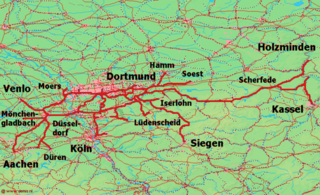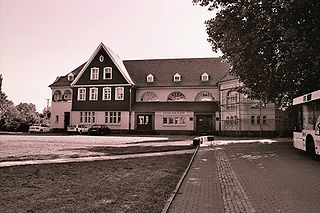
Witten Hauptbahnhof is a railway station in the town of Witten in western Germany. It is situated southwest of the town.

Line S3 is a S-Bahn in the Rhein-Ruhr network. It runs from Oberhausen over Essen to Hattingen Mitte. It is operated at 30-minute intervals, using Stadler FLIRT 3XL units.

Line S 9 is an S-Bahn line on the Rhine-Ruhr network, operated by DB Regio. It runs from Recklinghausen Hbf / Haltern am See in the north through Gladbeck West - Essen Hbf to Hagen (Westphalia) Main Station in the south. During the day two services per hour run between Wuppertal and Gladbeck West, one service per hour between Gladbeck and Recklinghausen Hbf and Gladbeck and Haltern am See and one service per hour between Wuppertal and Hagen, using FLIRT 3XL electric multiple units.

The Witten/Dortmund, Oberhausen/Duisburg railway is one of the most important railways in Germany. It is the main axis of long distance and regional rail transport on the east–west axis of the Ruhr and is served by Intercity-Express, InterCity, Regional-Express, Regionalbahn and S-Bahn trains.

The Ruhr Valley Railway is a partly abandoned railway line in the German state of North Rhine-Westphalia, running from Düsseldorf-Rath via Old Kupferdreh station, Bochum-Dahlhausen, Witten-Herbede, Hagen-Vorhalle and Schwerte to Warburg. It was built between 1872 and 1876 by the Bergisch-Märkische Railway Company, one of the three major private railway companies in the Ruhr area. The railway tracks that were built along the Ruhr river had a relatively uniform grade that was suitable for railway operations at the time.

Essen-Steele is located in the district of Essen-Steele in the German city of Essen in the German state of North Rhine-Westphalia. It is on the Witten/Dortmund–Oberhausen/Duisburg line and is classified by Deutsche Bahn as a category 4 station. It is served by the RB 33 (Rhein-Niers-Bahn) Aachen / Heinsberg, RE 49 (Wupper-Lippe-Express) and Rhine-Ruhr S-Bahn lines S1, S3 and S9.
The Düsseldorf-Derendorf–Dortmund Süd railway is a partially closed line in the German state of North Rhine-Westphalia from Düsseldorf-Derendorf station to Dortmund South station. Parts of it are still busy, including two sections used for the Rhine-Ruhr S-Bahn.

Essen-Steele Ost station is located in the district of Essen-Steele in the German city of Essen in the German state of North Rhine-Westphalia. It is on the Witten/Dortmund–Oberhausen/Duisburg line and is classified by Deutsche Bahn as a category 4 station. It is served by Rhine-Ruhr S-Bahn lines S 1 and S 3.

Bochum-Dahlhausen station is located in the Dahlhausen district of Bochum in the German state of North Rhine-Westphalia. The station building dates from the time of the First World War.

Essen-Horst station is located in the district of Horst in the German city of Essen in the German state of North Rhine-Westphalia. It is on the Essen-Überruhr–Bochum-Langendreer line and is classified by Deutsche Bahn as a category 6 station. It is served by Rhine-Ruhr S-Bahn line S 3 every 30 minutes and one bus routes, 167, every 10 minutes, operated by Ruhrbahn.

Bochum-Langendreer station is now a stop on the Rhine-Ruhr S-Bahn in the district of Langendreer in eastern Bochum in the German state of North Rhine-Westphalia. Langendreer formerly had a 40 hectare marshalling yard, which is now used as a depot, with the location code of EBLA. Until the 1980s, the yard was also the location of a passenger station, which was served by express trains.
The Mülheim-Heißen–Oberhausen-Osterfeld Nord railway is a line that formerly ran continuously in the western Ruhr region from Heißen to Osterfeld in the German state of North Rhine-Westphalia.

The Oberhausen-Osterfeld Süd–Hamm railway, also called the Hamm-Osterfeld line, is a 76-kilometre long double-track electrified main line railway at the northern edge of the Ruhr in the German state of North Rhine-Westphalia.

Essen-Überruhr station is located in the district of Überruhr in the city of Essen in the German state of North Rhine-Westphalia. It is on the Wuppertal-Vohwinkel–Essen-Überruhr line and is classified by Deutsche Bahn as a category 6 station.

Dortmund-Kruckel station lies on the border between the suburbs of Dortmund-Kruckel and Dortmund-Persebeck of the city of Dortmund in the German state of North Rhine-Westphalia on the Elberfeld–Dortmund line. The station is currently classified as a category 6 station. It is served by regional services and Rhine-Ruhr S-Bahn line S 5.

The Osterath–Dortmund-Süd railway is a historically significant line in the German state of North Rhine-Westphalia. Parts of it are closed, much of it is now used for freight only, but several sections are still used for Regional-Express, Regionalbahn or Rhine-Ruhr S-Bahn services.
The Duisburg-Ruhrort–Dortmund railway was built by the Cologne-Minden Railway Company in the area to the north of its original Ruhr line to improve connections to mines and factories in the northern Ruhr region, which is now in the German state of North Rhine-Westphalia.
The Bochum–Essen/Oberhausen railway was built by the Bergisch-Märkische Railway Company to the north of its main line through the central Ruhr to tap traffic from mines and factories in the northern Ruhr region, which is now in the German state of North Rhine-Westphalia.

The Bochum–Gelsenkirchen railway, also known as the Glückauf-Bahn, is a passenger railway from Bochum Central Station (Hauptbahnhof) to Gelsenkirchen Central Station in the German state of North Rhine-Westphalia. It is served by Regionalbahn passenger service RB 46). It is also used by freight traffic from Bochum freight yard at the former Bochum Süd station and Bochum-Präsident to Gelsenkirchen-Schalke Nord. The line was built in sections between 1867 and 1876 of the Bergisch-Märkische Railway Company. The curve connecting to Bochum Central Station was opened in 1979.

Bochum Nord station was a station on the Ostring in the city of Bochum in the German state of North Rhine-Westphalia. It was built by the Rhenish Railway Company between 1871 and 1874 and opened on 15 October 1874. The station, which was originally called Bochum Rheinisch ("Rhenish") station, for a long time served passenger and freight traffic on the Osterath–Dortmund Süd railway.

















